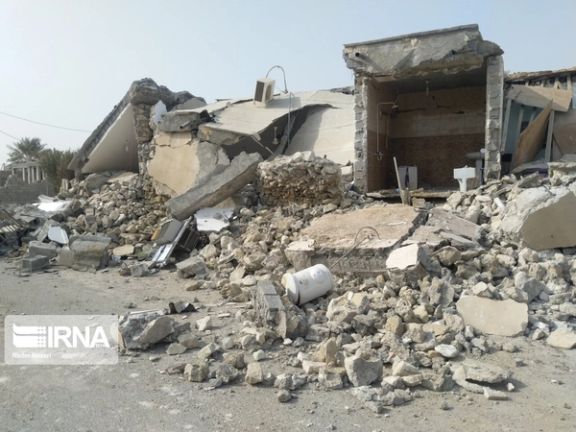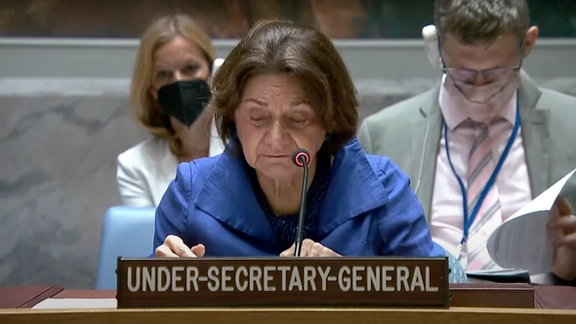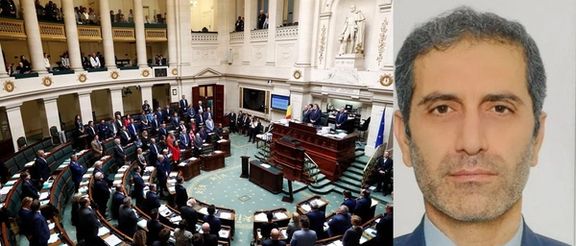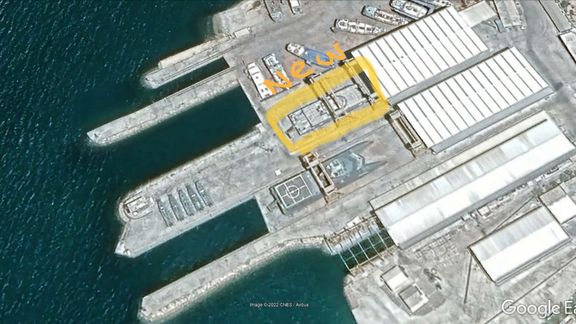A 6.1 Magnitude Quake and Aftershocks Kill At Least Five In Iran

At least five people were killed and 49 injured by two strong earthquakes followed by many aftershocks in southern Iran early on Saturday, July 2.

At least five people were killed and 49 injured by two strong earthquakes followed by many aftershocks in southern Iran early on Saturday, July 2.
A magnitude 6.1 earthquake hit Iran’s Hormozgan province, with the area hit soon after by two strong quakes of up to 6.3 magnitude.
Some 24 tremors, two with a magnitude of 6.3 and 6.1, followed the 2 a.m. local time quake that flattened the village of Sayeh Khosh near Iran's Persian Gulf coast. The most recent tremor occurred around 8 a.m., officials told state TV.
"All of the victims died in the first earthquake and no-one was harmed in the next two severe quakes as people were already outside their homes," said Foad Moradzadeh, governor of Bandar Lengeh country, quoted by the state news agency IRNA.
Emergency services spokesperson Mojtaba Khaledi told state TV that half of the 49 people injured had been discharged from hospitals.
Saeid Pourzadeh of the Kish island crisis task force said shipping and flights in that part of the Persian Gulf had not been affected by the quakes.
State TV said 150 quakes and tremors had struck western Hormozgan over the past month.
Major geological fault lines crisscross Iran, which has suffered several devastating earthquakes in recent years. In 2003, a magnitude 6.6 quake in Kerman province killed 31,000 people and flattened the ancient city of Bam.

Media outlets affiliated with Iran’s Revolutionary Guard have released an audio file in which Brigadier General Ali Nasiri denies “rumors” about his arrest on charges of espionage.
The audio interview with Hawza News, the news agency of Qom’s seminaries, was released on Friday in reaction to a Wednesday report by the New York Times claiming that Naseri was arrested a month ago on charges of spying for Israel.
He said in the file that he is doing his job despite the allegations but did not mention where in the IRGC he is serving since he was removed from his post at the Guard’s counter-intelligence unit. The fact that there is no video footage of him or any recent reports about his activities as part of the IRGC, strengthens the speculations that he may be in fact in detention as Iran is notorious for extracting confessions and statements under duress.
The Times described Nasiri as “a senior commander in the Revolutionary Guard’s Protection of Information Unit, tasked with oversight and supervision of the organization’s work,” although the paper sourced this to an April 21, 2019 story from Radio Farda that Naseri had been replaced in that position. The Iranian Students News Agency also reported at the time that Naseri had been removed.
There had been suggestions at the time that Nasiri had fled the country, with the Washington Free Beacon claiming he had defected to an Arab state in the Persian Gulf taking with him secret documents.

The United Nations has once again confirmed that missiles launched by Yeme’s Houthi militia at Saudi Arabia and the United Arab Emirates in the past two years were Iranian.
During her address to the Security Council during a meeting on Iran’s nuclear issue on Friday, UN Under-Secretary-General for Political and Peacebuilding Affairs Rosemary DiCarlo said that “the debris of nine ballistic missiles and six cruise missiles had similar design, characteristics and parts consistent with those of missiles examined previously and assessed to be of Iranian origin.”
She also called on both the United States and the Islamic Republic “to quickly mobilize in the same spirit and commitment to resume cooperation under the JCPOA.”
Together with the UN Secretary General, she “appealed to the US to lift or waive its sanctions as outlined in the plan and to extend the waivers regarding the trade in oil with Iran.”
They also urged Iran “to reverse the steps it has taken that are not consistent with its nuclear-related commitments under the plan,” noting that the International Atomic Energy Agency estimates Iram’s stockpile of enriched uranium is more than 15 times the allowable amount under the JCPOA, including uranium enriched to 20 percent and 60 percent “which is extremely worrying.”
Moreover, in a Thursday statement ahead of a Security Council meeting on the implementation of resolution 2231 that endorsed the 2015 nuclear deal, the UK, France and Germany called on Iran to stop and reverse its nuclear escalation, return to full cooperation with IAEA and seize the offer on the table without further delay.

The Belgian Parliament is set to review a bill on the exchange of convicts with Iran next week, which can facilitate a prisoner swap with the Islamic Republic.
A treaty between Iran and Belgium, which was signed in March, was brought before parliament on June 29 for approval.
If approved, it will potentially result in sending back Iranian diplomat Asadollah Assadi, who was sentenced to 20 years in prison for masterminding a failed terrorist attack in Europe, back to Iran.
Iranian dissidents have raised alarm on social media that the agreement would mean the Islamic Republic can send agents to target its critics in Belgium and, if arrested and convicted, Brussels will send them home to spend their sentences, because Iran can easily arrest a Belgian on false charges to arrange an exchange.
Assadi, 50, a former attaché at the Iranian embassy in Austria, was convicted of plotting to bomb a gathering of the exiled opposition group Mujahedin-e Khalq Organization (MEK) near Paris on June 30, 2018.
The Iranian diplomat -- the ever brought to trial in Europe for direct involvement in terrorism -- was arrested in Germany, where he did not enjoy diplomatic immunity, while he was on holiday. German authorities later extradited Assadi to Belgium.
Iranian officials say there are no plans to trade EU citizens held in Iran including Ahmadreza Djlali (Jalali), a Swedish-Iranian doctor that Iran says it will execute soon on charges of spying for Israel, with Iranians held in EU countries such as Assadi or Hamid Nouri, facing life imprisonment in Sweden over his role in prison executions of the 1980s.

Usage of highly polluting diesel and mazut fuels in power plants jumped in Iran in 2021 on top of increases in previous years, a BP report shows.
Iranian government entities have stopped publishing information on fuel use for power generation, but the latest report from the Parliament Research Center in 2020 indicted that the use of mazut had reached 6 billion liters (around 1.6 billion gallons), or 62 percent higher than in 2017.
Mazut is a heavy, dirty fuel which is banned in most countries unless it is blended with less polluting fuels, but in Iran it is used regularly as its export market is limited.
The same report indicated that power plants in 2020 used 11 billion liters of diesel, or more than double than in 2017. In the 2020-2021 winter daily natural gas shortage reached 170 cubic meters and that led to higher usage of polluting fuels.
From 2021, all government and industry sources in Iran stopped publishing figures about usage of dirty fuels in power pants, but scattered media reports indicated that natural gas shortages had started before the winter of 2021-2022, but in the cold months it reached the unprecedented deficit of 250 million cubic meters per day.
In fact, Mehr news agency in Tehran reported in late February that Iran had again become a net diesel importer for the first time since 2014, most likely because of high diesel usage for power generation.
The chronic shortage of natural gas is noteworthy in the context of recent talk about Iran possibly supplying the much-needed fuel to Europe in the aftermath of the Russian invasion of Ukraine.
In fact, Iran needs around $50 billion in investments to increase its natural gas production, although it has the world’s second largest reserves. At the time being, United States sanctions, as well as general investment risk factors make any infusion of capital and technology highly problematic, but even in the absence of such impediments, it would take years before the country can produce enough for significant exports.
Figures in the BP report show that in 2020 Iran produced 37 terawatts of its electricity from dirty fuels, but in 2021 it reached 49 terawatts. As a result, Iran’s greenhouse gas emissions reached the historic level of 893 million tons, an increase of 4.5 percent over 2020.
Iran is the sixth highest greenhouse gas contributor in the world, afterChina, the United States, India, Japan and Russia. Germany, with an 18-times bigger economy produces 28 percent less air pollution.
The BP report also indicates Iran’s nuclear electricity generation fell by 44 percent to 2.7 terawatts, and hydroelectric power generation decreased by 36 percent, due to drought.
Iran has also lagged in solar and wind energy generation. Last year it produced a combined total of 1.8-terawatt electricity from these renewables while neighboring Turkey generated 35 times more.
Nuclear, solar, and wind electricity generation constituted just over one percent of Iran’s 358 terawatts of electricity generation in 2021.

Satellite imagery shows Iran is constructing a new stealth missile boat on the island of Qeshm in the Strait of Hormuz in the Persian Gulf, the United States Naval Institute says.
The USNI, a non-profit professional military forum that offers independent, nonpartisan info on security issues, published a photo of the vessel at Qeshm Madkandaloo Shipbuilding Cooperative Company shipyard on Thursday. It is visible in Airbus commercial satellite imagery shared publicly on Google Earth.
The unidentified catamaran, probably a missile boat, is seen next to another new multi-hulled missile watercraft -- a Shahid Soleimani-class missile corvette – and is characterized by a clean-angled form, appearing stealthier than earlier types. The new type bears some similarities with the Soleimani-class in overall form but is noticeably smaller, measuring about 50 meters (166 feet) long and 14 meters (46 feet) across.
The new vessel appears to lack the helipad that the Shahid Soleimani-class has, but since it is currently unfinished, it is difficult to assess the final fit. However, it does have two cut-outs in the aft deck that are indicative of pop-up missile tubes, likely for four to eight Noor or Qader anti-ship missiles, the Iranian versions of the Chinese C-802 family of sea-skimming missiles roughly equivalent to the US Harpoon and Neptune types.
Last week, IRGC Navy Commander Alireza Tangsiri said Shahid Soleimani-class missile corvette, which carries helicopters, will be added to the IRGC Navy's fleet in the near future.
Late in June, Iran repeated its tactic of harassing American naval vessels in the Persian Gulf, as three IRGC speedboats came dangerously close to US ships.